History of Warwickshire facts for kids
This is about the exciting history of Warwickshire, a county in the middle of England. Long ago, its borders were different. To the northwest was Staffordshire, to the northeast Leicestershire, to the east Northamptonshire, to the west Worcestershire, to the south Oxfordshire, and to the southwest Gloucestershire. Some areas that were once part of Warwickshire, like Coventry, Solihull, Sutton Coldfield, and much of central Birmingham, are now part of the West Midlands. This change happened in 1974 because of a new law.
A big part of northwestern Warwickshire used to be covered by the ancient Forest of Arden. Even by the time of the Domesday Book (a very old survey), much of it was still forest. Later, many trees were cut down to help with industry. That's why many place names in this area end with "ley" or "leah" (meaning a forest clearing) or "-in-Arden," like Henley-in-Arden. Historically, two towns were very important: Warwick, the county town, and Coventry, a major medieval city.
Contents
Ancient Times in Warwickshire
The area of Warwickshire has been home to people for a very long time, possibly as far back as half a million years ago!
Stone Age Discoveries
During the Paleolithic (Old Stone Age), small family groups explored the thick forests, looking for food. They used simple stone tools like hand-axes. There's evidence of a temporary camp near Leamington Spa. This early period ended when the Ice Age arrived, and people left the area.
Humans returned about 10,500 years ago during the Mesolithic period (Middle Stone Age). As the weather got warmer, the forests grew back. These people were hunter-gatherers. They used bows and arrows and had domesticated dogs to help them hunt. They made tiny, sharp stone tools called microliths for their arrows. Over 20 sites from this time are known in Warwickshire, with an important tool-making site at Blacklow Hill near Warwick.
Around 6,000 years ago, people slowly started farming instead of just hunting and gathering. These Neolithic (New Stone Age) people raised sheep, pigs, and cattle. They also grew crops. They used fire and stone axes to clear parts of the woodland to build farms and fields.
Bronze and Iron Ages
The Bronze Age brought big changes. Scattered farming groups started to form larger tribes with powerful leaders. People began using metal, making tools and weapons from copper and bronze. Many bronze swords and spearheads have been found in Warwickshire. People even started caring about their looks, as two bronze razors were recently found! By 1500 BC, much of the woodland had been cleared for farming.
In the Iron Age, the area had small farmsteads, like the one at Wasperton near Warwick. The main building was a round house with a thatched roof, where families and some animals lived. Workshops and storage areas were built around it. A deep ditch often surrounded the whole settlement to keep out wild animals. During dangerous times, people might have gone to hill forts for safety, like Meon Hill or Oldbury near Nuneaton. About twelve Iron Age hillforts have been found in the Warwickshire area.
Roman Rule in Warwickshire

When the Roman invasion of Britain happened in AD 43, Warwickshire was on the edge of Roman territory. Important Roman roads like Watling Street and Fosse Way were built. The Fosse Way was the western border of Roman rule for many years. The area was heavily protected, and several military camps were set up to guard the roads. Ryknild Street was also built through Warwickshire, and a fort was established in what is now Birmingham. This fort was a base for the Roman army as they explored the Midlands.
Boudica's Last Stand
In AD 60/61, the Iceni tribe, led by their Queen Boudica, rebelled against the Romans. After burning down Colchester and London, Boudica likely followed the Roman general Suetonius up Watling Street. Many historians believe the final Battle of Watling Street happened near Manduessedum (modern-day Mancetter). Military items, including armor, have been found there, supporting this idea. Another possible location is east of Rugby.
After Boudica's defeat, the Romans sent more soldiers from Germany. A huge supply base was built at Lunt Fort in Baginton near Coventry. This fort is special because it has a circular arena, or gyrus, used for training horses. It might have been a place where horses from the Iceni were gathered after the battle.
Roman Towns and Industry
One important Roman settlement in Warwickshire was Alauna, which is now Alcester. It was a large town of about 18 hectares, located along Ryknild Street. There's also a suspected Roman fort nearby on Primrose Hill. Other important Roman settlements included Tripontium near Rugby and Manduessedum near Atherstone. The area around Manduessedum was known for its large pottery industry. The remains of up to thirty pottery kilns have been found there.
Anglo-Saxon Times
This period covers from when the Romans left Britain until the Norman invasion in 1066.
The Kingdom of Mercia
After the Romans left in the 5th century, Anglo-Saxon tribes settled in Warwickshire. The area became part of the powerful kingdom of Mercia. Mercia was a large kingdom covering much of central England.
In the early 9th century, Mercia became less powerful. In 878, large parts of eastern Mercia were given to Danish (Viking) invaders by King Alfred in a peace treaty. Watling Street, on the northeastern edge of Warwickshire, became the border between the Danelaw (the Danish kingdom) to the east and the smaller Mercia to the west.
Defending the Borders
Because Warwickshire was on the border between two kingdoms, it needed strong defenses against Viking attacks. Between 911 and 918, Æthelflæd, the "Lady of the Mercians" and King Alfred's daughter, took on this task. She built defenses at Tamworth in 914 and started building Warwick Castle in 916. There was fighting between the Danes and Saxons until the 11th century.
The building of the burh (a fortified town) by Æthelflæd in Warwick helped the town grow. Warwick was important enough to have one of two royal mints in Warwickshire, where coins were made. The name Warwickshire was first recorded in 1001, named after Warwick, which means "dwellings by the weir" (a low dam).
In 1016, Cnut invaded Warwickshire during his successful invasion against King Æthelred the Unready. He destroyed Coventry and killed the local saint, Osberg.
Medieval Period
This time stretches from the Norman invasion in 1066 to the Battle of Bosworth in 1485.
Castles and Market Towns
The Norman conquest in 1066 led to a lot of castle building. Much of Warwick Castle was built then, along with others at Kenilworth, Maxstoke, and Tamworth. Many other castles existed, but today only their earthworks (mounds and ditches) can be seen.
Many of Warwickshire's main towns, like Birmingham, Bedworth, Nuneaton, Rugby, and Stratford-upon-Avon, started as market towns during the Middle Ages.
Coventry's Importance
Throughout the medieval period, Coventry was the most important city in the county. It became one of the most important cities in England and a major center for the wool and textile trades. Coventry has been an important religious center since the 11th century, thanks to the monastery founded by Earl Leofric and his wife, Lady Godiva.
King Henry VI and his queen, Margaret of Anjou, often visited Coventry. In 1451, as a special favor, Coventry and some nearby villages became their own separate county. In 1459, a famous Parliament, sometimes called the "Parliament of Devils," met in Coventry. It declared the Duke of York and other nobles to be traitors at the start of a new phase of the Wars of the Roses.
The people of Coventry stayed loyal to King Henry. When Edward IV tried to enter the city in 1470, the gates were closed against him. However, once Edward was firmly on the throne, he took away the city's special rights. He only gave them back after the city paid a large fine.
Tudor and Stuart Times
This period goes from the start of Henry VII's rule in 1485 to George I becoming king in 1714.
Mary Queen of Scots
Mary Queen of Scots was held prisoner in Coventry twice, once in 1566 and again in 1569. She stayed in the mayor's house and later in the Bull Inn.
The Gunpowder Plot
The Gunpowder Plot of 1605 was a conspiracy with strong ties to Warwickshire. The main goal was to kill King James, but another important plan was to kidnap his daughter, Princess Elizabeth. She was staying at Coombe Abbey near Coventry, which was close to where most of the plotters lived. They wanted to make Elizabeth queen after the king and Parliament were gone.
Robert Catesby, the leader of the plot, was from Warwickshire. John Grant's house at Northbrook, Snitterfield, was where the conspirators met and stored gunpowder. Other plotters rented houses in the area, like Ambrose Rokewood at Clopton House near Stratford. Sir Everard Digby gathered Catholic nobles in the Midlands under the cover of a "hunting party" at Coughton Court.
After Guy Fawkes was caught in London, the other plotters rode to Warwickshire. They met at the Red Lion in Dunchurch to discuss their next steps. They raided Warwick Castle for supplies and then went to Norbrook for weapons. From there, they continued their escape. The plotters were finally caught at Holbeche House on the border of Staffordshire.
The English Civil War
During the English Civil War in the 17th century, Warwickshire mostly supported the Parliamentarians. Lord Brooke of Warwick Castle was a strong opponent of the king. The Battle of Edgehill (1642) was fought in Warwickshire, near the border with Oxfordshire.
In 1643, Prince Rupert of the Rhine, who led the Royalist forces, marched his soldiers through Henley-in-Arden on his way to Birmingham and looted the area. After his defeat at the Battle of Worcester in 1651, King Charles II escaped with the help of Jane Lane, Lady Fisher. She disguised the king as her servant and helped him travel through Warwickshire, passing through Wooton Wawen, Stratford-upon-Avon, and Long Marston. A walking path called the Monarch's Way follows his escape route.
Modern Warwickshire
This period covers from George I becoming king to today.
Industrial Growth
In the 18th and 19th centuries, Warwickshire became one of Britain's leading industrial counties. The coalfields in northern Warwickshire were very productive, helping Coventry and Birmingham grow industrially. However, Leamington Spa grew differently. It changed from a small village to a medium-sized town in the 19th century because of its popular spa water and tourism.
Warwickshire became a hub for Britain's canal system. Major routes like the Oxford Canal, the Coventry Canal, and later the Grand Union Canal were built through the county.
One of the first intercity railway lines, the London and Birmingham Railway, also ran through Warwickshire. By the 19th century, the county had a dense railway network. Towns like Nuneaton, Bedworth, and Rugby also became industrialized. Rugby's growth was especially helped by a major railway junction being built there.
Changing Borders
By the late 19th century, Birmingham and Coventry had become large industrial cities. This meant that administrative borders needed to change. In 1889, the administrative county of Warwickshire was created. Coventry and Birmingham became county boroughs, which meant they were managed separately from the rest of Warwickshire. Solihull later became a county borough too. These boroughs were still part of the larger ceremonial county of Warwickshire.
This situation lasted until 1974. Then, Coventry, Solihull, and Birmingham were completely removed from Warwickshire. They became part of the new West Midlands metropolitan county, along with parts of Staffordshire and Worcestershire.
The Warwickshire county that remained after 1974 has a rather unusual shape. It looks as if a large piece was taken out where Coventry, Solihull, and Birmingham used to be.
See also



